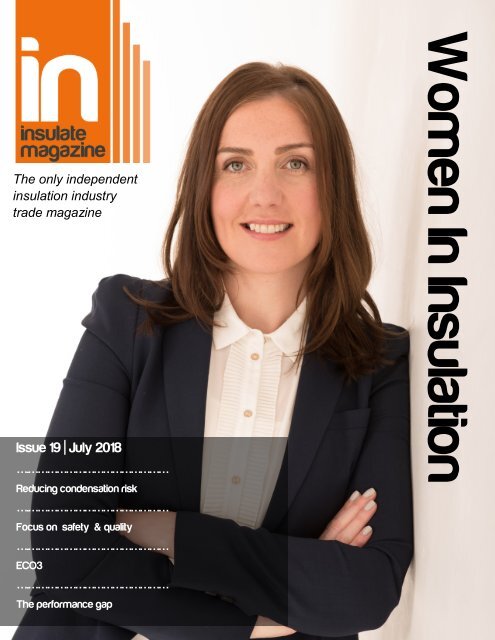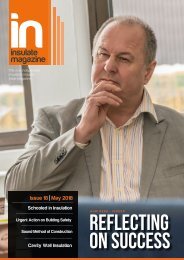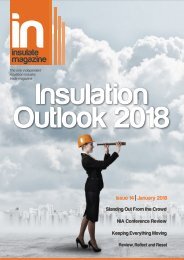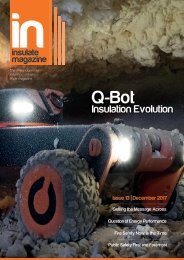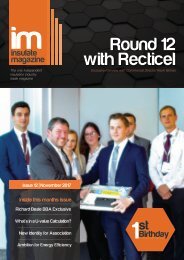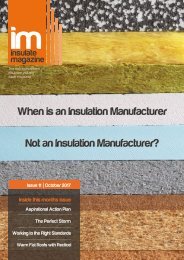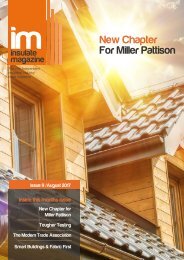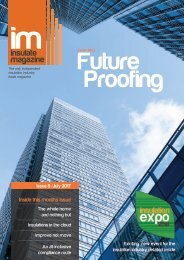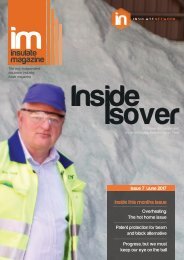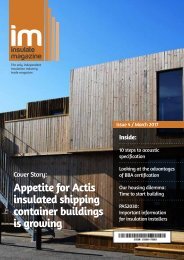Insulate Magazine Issue 19
Create successful ePaper yourself
Turn your PDF publications into a flip-book with our unique Google optimized e-Paper software.
The only independent<br />
insulation industry<br />
trade magazine<br />
<strong>Issue</strong> <strong>19</strong> | July 2018<br />
…..………………………………………<br />
Reducing condensation risk<br />
…..………………………………………<br />
Focus on safety & quality<br />
…..………………………………………<br />
ECO3<br />
…..………………………………………<br />
The performance gap<br />
Women In Insulation
Published on a monthly basis by Versanta Ltd<br />
Corser House, 17 Geen End, Whitchurch, Shropshire, SY13 1A<br />
Call 0<strong>19</strong>48 759 351<br />
Outside of the UK +44 <strong>19</strong>48 759351<br />
Monday - Friday 9am - 5.30pm<br />
Website: www.insulatenetwork.com<br />
Email: sales@insulatenetwork.com<br />
SUBSCRIPTION INFORMATION<br />
Anyone can subscribe for free online at<br />
https://insulatenetwork.com/insulate-magazine-free-subscription<br />
Subscriptions are available around the world free in digital format.<br />
Our subscriber list is occasionally made available to very carefully<br />
selected companies whose products or services may be of<br />
interest to you. Your privacy is of paramount importance to us<br />
and should you prefer not to be part of these lists then please<br />
email your details and a short message to<br />
sales@insulatenetwork.com<br />
DISPLAY ADVERTISING.<br />
Contact one of our sales staff to discuss your requirements on<br />
0<strong>19</strong>48 759 351.<br />
Publisher reserves the right to reject any advertising that in its<br />
opinion is misleading, unfair or incompatible with the character of<br />
the magazine.<br />
We adhere to the IPSO code of practice for editors. Further information<br />
can be found at www.ipso.org.uk<br />
BACK ISSUES OR REPRINTS<br />
Digital back issues can be found online at www.insulatenetwork.<br />
com<br />
For printed editions please email contact@insulatenetwork. com ,<br />
there will be a postage charge and handling fee of £15+VAT for<br />
each copy requested.<br />
CIRCULATION<br />
Digital: 6,024<br />
Print: 10,000<br />
Total: 16,024<br />
©VERSANTA LTD<br />
No part can be reproduced without the express permission of the<br />
publisher.<br />
WWW.INSULATENETWORK.COM
www.insulatenetwork.com<br />
Contents<br />
Welcome to the July edition of <strong>Insulate</strong> <strong>Magazine</strong>,<br />
we are back after a month away, we’re<br />
refreshed and ready to face the second half of<br />
2018 with vigour—promoting best practice<br />
and collaboration across the insulation industry<br />
This month we have great content from Thermal<br />
Economics on the topic of condensation,<br />
a full feature on the women in insulation and<br />
columns from all of the usual suspects!<br />
The debate on combustibles seems to have<br />
peaked at the government launching a full<br />
consultation. This consultation is seeking<br />
views on proposals to ban the use of certain<br />
materials. The consultation will also produce a<br />
detailed impact assessment based on the information<br />
it receives from this consultation to<br />
inform the final policy decision.<br />
Combatting Condensation 6<br />
…………………………………………………………………………………………….<br />
Women In Insulation 10<br />
…………………………………………………………………………………………….<br />
Each Home Counts Quality Drive 15<br />
…………………………………………………………………………………………….<br />
Women In Insulation 16<br />
…………………………………………………………………………………………….<br />
Closing the Performance Gap 24<br />
…………………………………………………………………………………………….<br />
Enjoy!<br />
Colin Heath<br />
Managing Editor<br />
colin@insulatenetwork.com<br />
@Colin_<strong>Insulate</strong><br />
The UK’s only dedicated<br />
trade journal for the insulation industry
www.insulatenetwork.com<br />
Insulation Insight<br />
Thermal Insulation:<br />
Retrofitting to existing homes without causing moisture problems<br />
John Hefford Talks combatting condensation<br />
Thermal insulation isn’t applied just to prevent high energy<br />
bills, it also has a significant effect on indoor air quality by<br />
preventing condensation risk and mould growth. However,<br />
sometimes adding insulation can make condensation problems<br />
worse; so how can insulation be retrofitted to existing<br />
homes without causing moisture problems?<br />
Causes of condensation<br />
Condensation occurs when water vapour comes into contact<br />
with a cold surface. This happens a lot in houses; and<br />
can be seen on single-glazed windows, on tiles and mirrors<br />
in poorly ventilated bathrooms, or parts of the wall where<br />
there is an uninsulated thermal bridge.<br />
Paul Forrester talked about thermal bridges in The Language<br />
of Insulation (<strong>Insulate</strong> <strong>Magazine</strong> <strong>Issue</strong> 17) and described<br />
how they can be caused by timber rafters or changing<br />
geometry within the building envelope at construction<br />
junctions. The effect of thermal bridges is that there is a<br />
greater, localised heat loss where the thermal bridge exists,<br />
resulting in lower surface temperatures in these areas.<br />
As the temperature falls, the ability of the air to retain moisture<br />
as water vapour also falls. The dewpoint is the temperature<br />
at which the air cannot hold any more water, and<br />
the air is said to be saturated or at 100% relative humidity.<br />
If the temperature on a surface falls below the dewpoint,<br />
the water vapour in the air next to it condenses into water<br />
droplets. Sometimes the water droplets are small and defy<br />
gravity by the friction resistance of the wall. Other times<br />
the droplets are large and run down in rivulets. On some<br />
surfaces, the droplets are absorbed but leave a damp<br />
patch or a water mark.<br />
There are bigger problems with condensation than just<br />
‘steamed windows’ that need to be wiped and dirty-looking<br />
marks on a wall. Condensation on organic materials can<br />
help create the perfect environment for toxic mould growth,<br />
which has an adverse effect on indoor air quality and occupant<br />
health.<br />
The right amount of insulation,<br />
infiltration and ventilation<br />
The Building Regulations specifically state that the building<br />
should be protected from the harmful effects of interstitial<br />
and surface condensation in Part C (Section 3 in Scotland);<br />
and this can either be done with insulation to keep temperatures<br />
above the dewpoint, ventilation to remove moisture<br />
from the building, or more appropriately a sensible combination<br />
of both!<br />
Some types of insulation will also make the building more<br />
air-tight, preventing water vapour from permeating through<br />
the walls and roof; and preventing infiltration of fresh air<br />
from outside to displace the moisture-laden air inside. The<br />
accumulation of moisture inside the building increases the<br />
dewpoint temperature as it becomes more difficult for the<br />
air to retain the water vapour.<br />
Insulation will also prevent the heating system from warming<br />
up the exterior surfaces, which means that inherent
The only independent insulation industry trade magazine<br />
moisture within the building materials could condense and<br />
remain as damp. When condensation occurs within a saturated<br />
building material it is referred to as interstitial condensation;<br />
and the risks include timber rot and weakening of<br />
masonry by freeze/thaw effects.<br />
On the other hand, ventilation increases heat losses as<br />
warm air is replaced with fresh, colder air from outside.<br />
Some mechanical ventilation systems also require constant<br />
operation and regular maintenance making them expensive<br />
to install and operate, especially if its full air conditioning for<br />
close control of temperature and relative humidity.<br />
Finding an optimum solution to condensation risk is a fine<br />
balance between just the right amount of insulation, the<br />
right amount of infiltration and the right amount of ventilation.<br />
No easy task, especially as the different strategies<br />
have adverse, knock-on effects with each other! However,<br />
knowing how insulation, infiltration and ventilation interact<br />
with each other can help to design an effective, energyefficient<br />
and cost-efficient system.<br />
Utilising predictive models<br />
Generally, the risk of surface condensation and mould<br />
growth can be limited by ensuring that the U-value doesn’t<br />
exceed 0.70 W∙m -2 ∙K -1 (0.35 W∙m -2 ∙K -1 for roofs), although<br />
this should really be assessed by calculating the surface<br />
temperature factor to check that there is no condensation or<br />
mould growth.<br />
The surface temperature factor (fRsi-value) is the ratio of<br />
the temperature difference between the surface saturation<br />
temperature and the external air temperature; and the temperature<br />
difference between the internal and external air<br />
temperatures. An fRsi-value can be calculated for planar<br />
elements such as floors, walls and roofs; and thermal bridges.<br />
The building element will comply with Building Regulations<br />
as long as the calculated fRsi-value is less than the<br />
critical value for surface condensation and mould growth.<br />
The addition of insulation will increase the fRsi-value; and<br />
increasing the air change rate with infiltration and an appropriate<br />
ventilation strategy will increase the critical value<br />
which makes mould growth less likely. Whilst it is theoretically<br />
possible to avoid moisture risk with ventilation alone,<br />
this would make for high energy bills!<br />
Keeping control of water vapour<br />
Interstitial condensation is best prevented by installing a<br />
vapour control layer to act as a barrier to water vapour permeating<br />
through the construction. Ideally, this should normally<br />
be installed on the warm side of the insulation; but<br />
some insulation products such as Alreflex 1L1 also have a<br />
high vapour resistance, so function as a vapour control layer<br />
as well.<br />
Interstitial condensation risk can be predicted with a vapour<br />
diffusion calculation; also known as a Glaser calculation.<br />
The Glaser calculation is a simplified prediction of interstitial<br />
condensation at different interfaces within the construction<br />
over twelve months; and will check if the condensation will<br />
evaporate during the summer or whether it will continue to<br />
accumulate over time.<br />
Unlike calculations for surface humidity, Glaser calculations<br />
cannot be used to predict interstitial condensation at thermal<br />
bridges; although this can be done with advanced hygrothermal<br />
simulations. Where appropriate, Thermal Economics<br />
would normally include a Glaser calculation in a<br />
condensation risk analysis.<br />
Installing a vapour control layer like Alreflex 1L1 to prevent<br />
interstitial condensation will also reduce infiltration, which
The only independent trade magazine for the insulation industry<br />
affects the critical surface temperature factor for mould<br />
growth; and may have an effect on the chosen ventilation<br />
strategy, so thought should always be given checking<br />
that ventilation is still sufficient when adding insulation.<br />
It might be tempting at this stage to think that all problems<br />
can be avoided by covering the walls with vapour<br />
control barriers and installing a mechanical ventilation<br />
system with heat recovery (MVHR) unit! However, this<br />
will not meet the conservation of fuel and energy requirements<br />
in Part L for England and Wales, or Section<br />
6 for Scotland.<br />
Designing an effective, energy-efficient<br />
and cost-efficient system<br />
There is no silver bullet to keeping homes comfortable<br />
to live in. Condensation risk should be managed with a<br />
combination of good insulation, infiltration and ventilation<br />
strategies that work together.<br />
Calculations will not only identify if there is a risk of<br />
condensation forming but also the point at which it<br />
would form.<br />
At Thermal Economics, to ensure compliance for<br />
retrofits, our technical team usually carries out these<br />
calculations for free for customers buying our products<br />
(where a steady-state, one-dimensional vapour diffusion<br />
analysis is appropriate). However, for any build ask<br />
for a ‘condensation risk analysis’ before buying products<br />
so that you know Part C will also be met in your<br />
project.<br />
John Hefford is a Senior Consultant and part of<br />
the technical team at Thermal Economics.<br />
Thermal Economics has been delivering thermal<br />
and acoustic insulation products for over<br />
35 years.<br />
The company helps customers to make the<br />
best decisions for their builds by providing<br />
support throughout the project – from specifying<br />
and design through to ensuring that its<br />
installed products meet building regulations –<br />
as and when we are needed.<br />
www.thermal-economics.co.uk<br />
www.insulatenetwork.com
The only independent insulation industry trade magazine<br />
Women in Insulation<br />
<strong>Insulate</strong> Network sent questionnaires to some of the women we know who work in insulation<br />
to discuss what its like to be a women in a predominantly male dominated industry.<br />
Here's what they had to say…..<br />
aided your time at Insulation Manufacturers Association<br />
Mel Price is Assistant Chief Executive at<br />
Insulation Manufacturers Association.<br />
I<br />
n a few words could you describe your role at<br />
Insulation Manufacturers Association<br />
am the assistant Chief Executive; my<br />
role is varied but essentially I support<br />
the Chief Executive and the membership in<br />
representing the views of the association<br />
across the standardisation, regulations and<br />
political arena. I work closely with our technical<br />
committee, policy group and marketing<br />
and communications teams as well as<br />
administering the organisation.<br />
How has your previous employment experience<br />
I have worked with IMA for 26 years now<br />
but was formerly with BSI so this gave me a<br />
good insight into the world of standardisation<br />
at a UK, European and International<br />
level, which has proved invaluable. I also<br />
volunteer with two charities in the UK and<br />
my role as a trustee and manager has given<br />
me a wide range of skills and contacts<br />
which have been transferable into the workplace<br />
and vice versa.<br />
What have the highlights and challenges been<br />
during your time at Insulation Manufacturers Association?<br />
The highlight has been seeing the PIR industry<br />
grow, with the product going from<br />
being relatively unknown when I started in<br />
<strong>19</strong>92 to becoming one of the largest thermal<br />
insulation types in use in the UK today.<br />
<strong>Insulate</strong> Feature
I have had the privilege of working with a<br />
huge number of people in the industry over<br />
such a long period, all of whom have<br />
shown the utmost professionalism and<br />
passion for the industry and I have learnt<br />
so much from them. The lowlight for the<br />
whole industry must be the Grenfell Tower<br />
tragedy and having to deal with the enormous<br />
range of challenges that have arisen.<br />
How does Insulation Manufacturers Association<br />
support equality in the workplace?<br />
We are a small team and luckily I’ve never<br />
been treated as anything other than an<br />
equal.<br />
What do you think is the biggest issue for women<br />
in the workplace?<br />
I’m not sure there is one single issue but<br />
gender stereotyping and the perception<br />
that men should “take charge” is still commonplace<br />
as is the inability in some sectors<br />
for women to secure those top jobs.<br />
Do you think it's right women should be paid<br />
less for doing the same job as men because<br />
they have to take career breaks?<br />
No. I find it disappointing that 100 years<br />
after the Suffragists and Suffragettes<br />
strove for women’s votes that we are still<br />
having to have conversations like these.<br />
Neither women or men should be penalised<br />
for taking career breaks. If they are<br />
doing the same job, they deserve the same<br />
pay regardless of what stage they are at in<br />
their career. There needs to be greater<br />
transparency around salaries and recruitment.<br />
Salaries are much clearer in the<br />
public sector but in the private sector less<br />
so. Until we become more open about salaries<br />
the disparity will continue and probably<br />
only legislation around this will change<br />
matters.<br />
Anything you would like to add?<br />
In 26 years it has been great to see so<br />
many women come into the insulation industry<br />
and into construction more generally,<br />
but we are still a long way off construction<br />
featuring as a first-choice career option<br />
for women. More needs to be done to engage<br />
young people of school and college<br />
age about the options and pathways into<br />
the different elements of the industry.<br />
<strong>Insulate</strong> Feature
Elain Gardner is Commercial<br />
Manager at SIP BUILD UK<br />
In a few words could you describe your role at<br />
SIP Build UK?<br />
I was brought into the SIP Build UK to identify<br />
business opportunities across new markets.<br />
SIPS are extremely popular within the<br />
self-build market due to the excellent advantages<br />
including thermal performance<br />
and speed of construction reduced energy<br />
bills due to excellent air tightness of the<br />
building envelope for the home owner.<br />
These advantages are also transferring<br />
across to social housing, residential projects,<br />
education and health.<br />
How has your previous employment experience<br />
aided your time at SIP Build UK?<br />
I worked at SIG PLC for almost 21 years, I<br />
started in March <strong>19</strong>97 as a graduate and<br />
was given numerous opportunities to develop<br />
my career with the building and construction<br />
market including: managing a telesales<br />
team of 12 people, building product<br />
management along with Glass/Rock fibre<br />
and roofing category management. Within<br />
these roles I was given an excellent experience<br />
working for a top 250 FTSE company.<br />
I developed key relationships with suppliers<br />
jointly developing new products for market<br />
and identifying sales opportunities.<br />
What have the highlights and challenges been<br />
during your time at SIP Build UK?<br />
We have a dynamic, forward thinking<br />
team with extensive knowledge and years<br />
of experience at SIP Build UK. We are<br />
customer service focused offering face to<br />
face interaction from concept, design,<br />
technical support and site visits during installation<br />
to ensure quality service. We<br />
are experiencing an unprecedented increase<br />
in the number of enquiries due to<br />
the increasing popularity of SIP’s<br />
(Structural <strong>Insulate</strong>d Panels) so continuing<br />
to exceed customer expectations is<br />
our top our priority!<br />
How does SIP Build UK support equality in the<br />
workplace?<br />
Regardless of gender SIP Build UK offer<br />
everyone an equal opportunity to work<br />
within the business. We have 4 women<br />
working in the business all adding value in<br />
a variety of roles at differing levels including<br />
senior management.<br />
What do you think is the biggest issue for women<br />
in the workplace?<br />
Women need to be seen as serious/<br />
credible members of any construction<br />
team, we should encourage women to enter<br />
such an exciting and professional industry<br />
at every level.<br />
www.insulatenetwork.com<br />
<strong>Insulate</strong> Feature
The only independent trade magazine for the insulation industry<br />
Women in Insulation<br />
There is an average 10% pay gap between men and<br />
women in full time jobs and 34.5% in part time jobs.<br />
(Stonewall 2017) How do you feel the industry could assist<br />
in addressing this?<br />
The government has made the first move to<br />
address this. Companies and public-sector<br />
bodies with more than 250 employees must<br />
have now reported their gender pay gap by<br />
April 4, 2018. What will be interesting is how<br />
the government will act against companies<br />
that deliberately pay women less than men for<br />
doing the same work. The next step must be<br />
to challenge smaller companies who are also<br />
actively discriminating by gender.<br />
Anything you would like to add?<br />
The construction industry offers excellent career<br />
opportunities to all, changing building<br />
regulations ensure the industry continually<br />
evolves which makes it an exciting and fun<br />
industry to be a part of. We do however need<br />
more women entering the construction industry<br />
within technical and leadership roles. I<br />
have met some great people over the last 20+<br />
years working in a variety of different roles<br />
and look forward many more ahead.<br />
<strong>Insulate</strong> Feature
www.insulatenetwork.com<br />
<strong>Insulate</strong> Columnist<br />
Supporting Each Home Counts Quality Drive<br />
One of the key recommendations from the<br />
Each Home Counts Review is the introduction<br />
of a new Quality Mark which is<br />
currently being developed by Trustmark.<br />
The Quality Mark will include a variety of<br />
qualifying criteria including; PAS2030 and<br />
PAS2035 (specification and standards for<br />
the installation of energy efficiency products)<br />
certification.<br />
The National Insulation Association (NIA)<br />
is supporting the development of these<br />
new requirements by feeding into Trustmark’s<br />
work on the content and design of<br />
the Quality Mark scheme for insulation<br />
products and inputting to the new PAS’s<br />
via membership of the national Steering<br />
Group and Measures Experts Groups. In<br />
addition, the NIA is working with its members<br />
and other industry stakeholders in<br />
developing a number of standards and<br />
specifications for insulation products –<br />
these include:<br />
Revisions to the current Room in Roof<br />
and Loft Insulation Best Practice Guides.<br />
Specification for the Design and Installation<br />
of Retrofit Floor Insulation.<br />
Commenting on the work Neil Marshall<br />
Chief Executive of the NIA said: “Whilst<br />
we’re supportive of these initiatives it is<br />
vitally important that they are informed by<br />
the industry so that it can ensure a desired<br />
outcome and that they are workable<br />
for all parties involved.<br />
Specification for External Wall Insulation<br />
Weathering Design Details<br />
Post Installation Maintenance Schedule<br />
for External Wall Insulation.
The only independent trade magazine for the insulation industry<br />
In a few words could you describe<br />
your role at MIMA?<br />
As one of my members said my role is<br />
“herding cats”….however there may be<br />
a soupçon of truth in this but most people<br />
know by now that I am not a traditional<br />
trade association Executive Director.<br />
My official role is to ensure that MI-<br />
MA provides an authoritative source of<br />
independent information and advice on<br />
glass and stone wool insulation as well<br />
as promotes the benefits of mineral<br />
wool insulation and the contribution it<br />
makes to the energy efficiency of buildings<br />
and the comfort of their occupants.<br />
However I have also expanded my focus<br />
to ensure a small, but perfectly<br />
formed trade body punches above its<br />
weight with its stakeholders including<br />
the governments, becomes more public<br />
-facing and works with other likeminded<br />
organisations and individuals<br />
through projects, campaign and coalitions.<br />
How has your previous employment experience<br />
aided your time at MIMA?<br />
My previous experience has most definitely<br />
helped! My expertise over the last<br />
25 plus years has been working with<br />
some complex industries and providing<br />
strategies and solutions on often contentious<br />
issues and people with challenging<br />
personalities. Building coalitions<br />
within these environments and working<br />
in politics at all levels makes you a fairly<br />
resilient, determined and creative person!<br />
I don’t take ‘no’ for an answer!<br />
What have the highlights and challenges<br />
been during your time at MIMA?<br />
The biggest challenge has been to understand<br />
the dictionary of acronyms related<br />
to this industry. I thought “what<br />
have I done” at my first MIMA meeting,<br />
however my new colleagues around the<br />
table and the excitement of such big<br />
challenges ahead made me stick with it.<br />
Highlights include bringing together<br />
Women in Insulation<br />
<strong>Insulate</strong> Feature
www.insulatenetwork.com<br />
wide ranging organisations under the EEIG<br />
campaign banner with a shared objective to<br />
bring all homes up to EPC C by 2035 and<br />
when the current Energy Minister, Claire<br />
Perry reflected this vision so strongly in the<br />
Government’s Clean Growth Strategy it<br />
could have been a ‘cut n paste’ job. It’s<br />
great to see the results and outcomes from<br />
sheer hard work as part of a team.<br />
Finally the ultimate highlight is the people I<br />
work with….or dare I say the MIMA family<br />
and others in the industry! I could name<br />
them but wouldn’t want to embarrass<br />
them…<br />
How does MIMA support equality in the workplace?<br />
MIMA members and particularly the MIMA<br />
Board – John Sinfield, Knauf Insulation; David<br />
Travill, Isover Saint Gobain; Darryl Matthews<br />
& Rory Moss, Rockwool; and Ken<br />
Munro, Superglass - have always been a<br />
great support – from when they employed<br />
me when I was up against three male candidates,<br />
to giving me the flexibility and under<br />
Sarah Kostense-Winterton is<br />
executive director at The<br />
mineral wool manufacturers<br />
association<br />
standing as a woman with a busy life and a<br />
family outside of work. Trust and straight<br />
talking is an important part of this – they<br />
know I will always get the job done!<br />
What do you think is the biggest issue for women<br />
in the workplace?<br />
Finding the work/life balance and being disciplined<br />
about it. Women are ‘doers’, they<br />
are determined and they want to succeed.<br />
Sometimes we need to approach issues differently<br />
to get the desired outcome.<br />
Employers need to better understand and<br />
be flexible with women in the workplace – I<br />
became my best after maternity leave but I<br />
also realized that I am not an office or desk<br />
person. What works when you are a younger<br />
woman doesn’t necessarily work when<br />
you are ‘more mature’.<br />
<strong>Insulate</strong> Feature
Women in Insulation<br />
Do you think it's right women should be paid<br />
less for doing the same job as men because<br />
they have to take career breaks?<br />
I think we must remember that taking a career<br />
break doesn’t mean your career is<br />
over but you may have to think differently<br />
and consider a different approach to your<br />
career and sometimes that involves compromise.<br />
A career is important but it is not<br />
your entire life. Few careers are remembered<br />
when you have met your maker!<br />
Change is happening and employers are<br />
beginning to open up to a more flexible<br />
and understanding approach which will get<br />
the best out of all employees!<br />
compromise may be required and this may<br />
mean in pay as well, but if we are seeing a<br />
narrowing of the gap we are going in the<br />
right direction.<br />
Anything you would like to add?<br />
It is encouraging to see increasing numbers<br />
of women in the insulation industry<br />
and it can only improve the working environment.<br />
I am happy working in a maledominated<br />
industry and it can be a lot of<br />
fun but sometimes it’s nice to drink wine<br />
(preferably with bubbles) instead of beer<br />
and not talk about football! Excuse the clichés!<br />
There is an average 10% pay gap between<br />
men and women in full time jobs and 34.5% in<br />
part time jobs .(Stonewall 2017) How do you<br />
feel the industry could assist in addressing<br />
this?<br />
It is important that this issue remains a<br />
high priority and women have a part to play<br />
in changing this. As companies become<br />
more transparent and as cultural change<br />
takes hold we should see this gap narrow.<br />
However with changes in work practices<br />
and increasing flexibility within jobs some<br />
<strong>Insulate</strong> Feature
The only independent trade magazine for the insulation industry<br />
Women in Insulation<br />
Louise Foody is Director of digital transformation<br />
and customer experience at Kingspan<br />
In a few words could you describe your role at<br />
Kingspan<br />
I am the Director of the digital transformation and<br />
customer experience programme at Kingspan. I<br />
am driving our vision for this new digital and experience<br />
economy.<br />
How has your previous employment experience<br />
aided your time at Kingspan<br />
I have been working in the construction sector<br />
since I graduated from college. Growing up I always<br />
had an appreciation for well-crafted houses<br />
and buildings, and I joined Kingspan on the back<br />
of an application to the company’s graduate programme.<br />
That application has been my ticket to<br />
heading up teams around the world, living in the<br />
UK and Canada, implementing global strategies<br />
and sitting on the board of an exciting software<br />
company, Invicara.<br />
What have the highlights and challenges been<br />
during your time at Kingspan<br />
Oh there has been so many! Launching the first<br />
APP in the North American construction industry<br />
was a great day− there is nothing like first mover<br />
advantage. The biggest challenge is finding great<br />
people. Once you have them it is gold, but it can<br />
be a long process and attracting people to our<br />
industry is what I try to do a lot of.<br />
How does Kingspan support equality in the<br />
workplace?<br />
I have consistently received nothing but encouragement<br />
and support throughout my career with<br />
Kingspan, and I can’t stress how important it is. I<br />
never felt any different to my male peers. If anything,<br />
I may have received more encouragement<br />
as I climbed the ranks. The support I have experienced<br />
has permeated into my leadership style,<br />
and my focus is on encouraging my teams’ members,<br />
female and male, across the world, to<br />
stretch themselves, so they can be the next generation<br />
of leaders in the business.<br />
What do you think is the biggest issue for women<br />
in the workplace?<br />
Many sectors are, by their very nature, more<br />
heavily represented by one gender than the other<br />
and it’s not surprising that there is a lack of diversity<br />
in the construction industry when compared<br />
with other sectors. It is no secret that Boards<br />
need more women and, in my experience, this<br />
resonates with business leaders. I do fundamentally<br />
believe that senior roles for women exist in<br />
every industry, and I am proof of it.<br />
<strong>Insulate</strong> Feature
www.insulatenetwork.com<br />
Do you think it's right women should be paid less for doing<br />
the same job as men because they have to take career<br />
breaks?<br />
Of course not. Both men and women should be paid<br />
equal for the same job. It’s important to never lose sight<br />
of the fact that, at the end of the day, the candidate most<br />
deserving of a role is the person with the best ability to do<br />
the job. I want future generations of women to look to our<br />
industry and see one which welcomes their talents, values<br />
their abilities and offers them the chance to grow as<br />
individuals, regardless of their gender.<br />
There is an average 10% pay gap between men and<br />
women in full time jobs and 34.5% in part time jobs.<br />
(Stonewall 2017) How do you feel the industry could assist<br />
in addressing this?<br />
One of the most common explanations for the gender pay<br />
gap is that there are less women in senior positions.<br />
Women not only need to be able to see that there is a<br />
clear path for them up the career ladder, but they need to<br />
have the confidence to go for it.<br />
Given the lack of females on Boards, it is very possible that in many organisations there<br />
are no female role models for female employees, and it makes some roles difficult to perceive<br />
as possibilities. I do truly believe that it is our responsibility as women to fearlessly<br />
say yes when a career opportunity comes our way, even if we don’t have the blueprint for<br />
what that opportunity might look like.<br />
Anything you would like to add?<br />
If you want it, go for it and take chances.<br />
<strong>Insulate</strong> Feature
www.insulatenetwork.com<br />
Women in Insulation<br />
In a few words could you describe<br />
your role at Paroc?<br />
I work in Paroc Building Insulation<br />
as Development Manager.<br />
My role is to increase stone<br />
wool market demand by influencing<br />
on the building regulations<br />
and standardization work,<br />
to contribute to the continuous<br />
development of our product<br />
offering to meet current and<br />
future customer needs and<br />
keep the markets open for Paroc<br />
stone wool products via<br />
certification development.<br />
How has your previous employment<br />
experience aided<br />
your time at Paroc<br />
I have worked in Paroc over 18<br />
years, so it is already quite a<br />
long time since my previous<br />
employment. After completing<br />
the school and before joining<br />
Paroc, I worked for 3 years at a<br />
house factory, where I got a<br />
good understanding of the industrial<br />
process of residential<br />
construction. Now I look at the<br />
house factory from an insulation<br />
supplier perspective and<br />
understand better about their<br />
needs.<br />
What have the highlights and<br />
challenges been during your<br />
time at Paroc?<br />
I have had the privilege to work<br />
with the best experts in the<br />
building industry and meet a<br />
huge number of people from<br />
different organisations.<br />
As a challenge I could mention<br />
that this work is not taught in<br />
school - the learning happens<br />
through experience, attempts<br />
and mistakes.<br />
How does Paroc support<br />
equality in the workplace?<br />
Employees are treated as individuals,<br />
so gender roles are<br />
not visible in any of the activities.<br />
The company has an<br />
equality plan which contains<br />
different indicators of equality<br />
to ensure the implementation<br />
of the plan; for example employee<br />
salaries are compared<br />
each year according to gender<br />
to ensure that differences are<br />
relatively low.<br />
What do you think is the biggest<br />
issue for women in the<br />
workplace?<br />
In my view, women are generally<br />
forced to work twice as<br />
hard to achieve a better position<br />
in working life. In addition,<br />
they will do another working<br />
day at home maintenance and<br />
child rearing. Sometimes balancing<br />
between family and career<br />
can take its toll and the<br />
women prioritise family above<br />
their career.<br />
<strong>Insulate</strong> Feature
There is an average 10% pay gap<br />
between men and women in full<br />
time jobs and 34.5% in part time<br />
jobs.(Stonewall 2017) How do you<br />
feel the industry could assist in addressing<br />
this?<br />
If the transparency of wage systems<br />
could be increased and the<br />
salary of each position would be<br />
known to everyone, it would be<br />
easy to eliminate the pay gap between<br />
men and women.<br />
Anything you would like to add?<br />
Construction is traditionally maledominated<br />
field, but I'm happy to<br />
see that the insulation business attracts<br />
greater amounts of capable<br />
women. Women are effective and<br />
bring soft values to building industry<br />
when men are found fair and nice<br />
co-workers. We need good combination<br />
of men and women to create<br />
a good and efficient work community.<br />
Do you think it's right women should be paid<br />
less for doing the same job as men because<br />
they have to take career breaks?<br />
The salary should be based on job, people's capabilities<br />
and skills, not the time they have spent<br />
in the company. Therefore breaks shouldn`t affect<br />
the salary. Of course many times experience<br />
is also increasing people's capabilities<br />
Susanna Tykkä-Vedder is a<br />
Development Manager in<br />
Building Insulation for Paroc<br />
<strong>Insulate</strong> Feature
<strong>Insulate</strong> Columnist<br />
CLOSING THE<br />
PERFORMANCE GAP<br />
Simon Storer is Chief Executive on Insulation Manufacturers Association<br />
The performance gap between design and built<br />
performance is a well-documented and contentious<br />
issue in the construction industry, especially<br />
in relation to a building’s energy usage<br />
and consumption. Although the debate has garnered<br />
a high-level of attention, practical solutions<br />
are yet to be outlined and resolved.<br />
To drive this important industry change, the Insulation<br />
Manufacturers Association (IMA) and<br />
fellow representatives participated in a dynamic<br />
and thought-provoking roundtable discussing<br />
the problematic performance gaps between design<br />
and built performance. Taking place recently<br />
at the Royal Exchange, Manchester, the<br />
roundtable explored the detrimental effect the<br />
performance gap is having on energy use in<br />
buildings.<br />
The debate sparked various opinions and insights,<br />
however the ultimate question is: what<br />
can we do to reduce the performance gap? Is it<br />
not about managing expectations?<br />
Attended by industry experts, discussion flowed<br />
throughout the event, with key areas emerging as<br />
top-priority points for further perusal including: targeting<br />
the performance gaps in the design and installation<br />
stages of a project.<br />
The roundtable proceeded to debate the various<br />
actions the industry can take to offer solutions to<br />
these issues including; housebuilder accountability,<br />
better public and client education and more rigorous<br />
building performance legislation. With a building’s<br />
energy consumption often up to twice the amount<br />
than initially predicted, it is high time that this issue<br />
was tackled, in order to make buildings better, safer<br />
and more energy-efficient.<br />
Accountability<br />
No housebuilder wants to be seen as taking a risk<br />
when it comes to building homes for people to live<br />
in. However, with more and more companies using<br />
‘value engineering’ to stay on course with the government’s<br />
demands to build more homes, corners<br />
are, inevitably, cut. Whether it’s a labourer modifying<br />
a complex installation onsite without the<br />
knowledge to do so or simple product substitution,<br />
this ‘make-do’ mentality of working must change.<br />
Companies must be held accountable for any under<br />
-performance, especially if it is compromising a<br />
building’s long-term efficiency and safety.
Managing expectations<br />
Building owners really need to be better educated<br />
about what they should expect and demand<br />
from their building. When it comes to housebuying,<br />
the majority of potential homeowners are<br />
often more focussed on the shade of their timber<br />
flooring rather than whether their building is<br />
equipped with the thermal efficiency to meet current<br />
and future standards. Homeowners simply<br />
lack insight on how their buildings perform, so<br />
when they underperform, they really are none<br />
the wiser.<br />
This is, in part, a result of little to no education<br />
on what homeowners can expect from a building.<br />
Homeowners can see and touch their flooring<br />
or walls but they can’t see their building’s key<br />
fabric components, such as the wall or floor insulation.<br />
By providing a more comprehensive, holistic<br />
view of the internal properties of a building,<br />
the public will have a more robust perception of<br />
how their building should be performing. Improved<br />
transparency will benefit all.<br />
Not only does the public’s expectation in terms<br />
of housing require attention, the clients for nondomestic<br />
buildings also need to be instructed.<br />
And this is in everyone’s interest. All clients<br />
would benefit from an improved understanding of<br />
how a building should perform. Learning about a<br />
building’s mechanics will ensure clients place<br />
more focus on occupant health and wellbeing as<br />
opposed to mere aesthetics - and meeting their<br />
KPIs.<br />
More rigorous inspection and compliance<br />
In order to truly address and reduce the performance<br />
gap, the industry is ultimately reliant on<br />
standards being met and decision-makers being<br />
held accountable. There must be rigorous inspection<br />
and compliance to ensure all regulations<br />
are met. We can no longer accept underperforming<br />
buildings just because there are not<br />
enough people with sufficient knowledge or authority<br />
asking the right questions. With this model,<br />
all we are doing is stacking up problems for<br />
the future as well as cheating the current buyers<br />
and occupants.<br />
IMA was delighted to hold such a compelling<br />
roundtable which created a space for industry<br />
experts to share their perspectives on the performance<br />
gaps from design to construction. The<br />
event was a great opportunity to share important<br />
insights on this crucial topic.<br />
As a collective, the industry recognises the problems.<br />
We also have the ability to meet the higher<br />
standards that many are crying out for. The current<br />
model is not working, but will the cultural<br />
change that the industry needs be adopted so<br />
that issues like the damaging performance gap<br />
become a thing of the past?<br />
For more information about Insulation Manufacturers<br />
Association please visit<br />
www.insulationmanufacturers.org.uk


